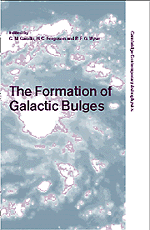What are Galactic Bulges?
from Part 1 - Introduction
Published online by Cambridge University Press: 10 November 2010
Summary
What are Galactic Bulges? I provide a brief overview of the observations and their interpretations, concluding that remarkably little is robust, remarkably little is well-defined, and remarkably little is well-explained. Galactic bulges are a subject ripe for HST and the large telescopes.
Definitions
What is a galactic bulge? A crucial pre-requisite to answering this question is to define the terminology. ‘Galactic’ seems innocuous, but is not. In discussion of bulges many people decree bulges to be synonymous with (small) ellipticals. Others note that a bulge is defined only relative to a disk. Are bulges simply small ellipticals? Did they form in the same way? Is the existence of a disk irrelevant to the history of a bulge?
Which leaves us to define a ‘bulge’. One must beware definitions which are self-fulfilling as much as one must beware definitions which are not restrictive. A consideration in a valuable definition must be the utility of bulges in defining the Hubble sequence. The invaluable Carnegie Atlas of Galaxies (Sandage & Bedke 1994) raises both a working definition and a clue to interpretation:
“One of the three classification criteria along the spiral sequence is the size of the central amorphous bulge compared with the size of the disk. The bulge size, seen best in nearly edge-on galaxies, decreases progressively, while the current star-formation rate and the geometrical entropy of the arm pattern increases, from early Sa to Sd, Sm and Im types”.
- Type
- Chapter
- Information
- The Formation of Galactic Bulges , pp. 1 - 8Publisher: Cambridge University PressPrint publication year: 2000

